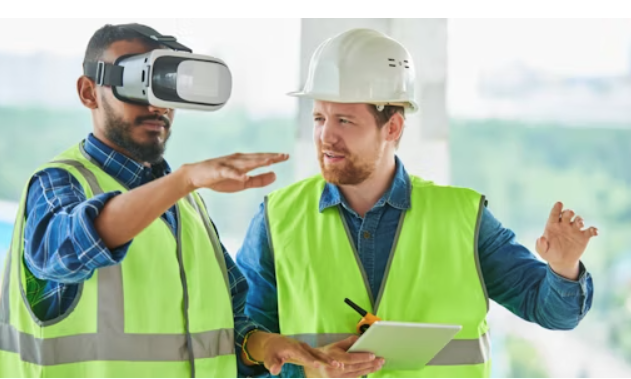
From Meta’s Oculus to Apple’s Vision Pro, Virtual Reality (VR) headsets are consistently making headlines. VR is a three-dimensional immersive simulation that provides a multi-sensory experience. While this may sound like something out of a James Cameron film, or a video game, VR technology is offering groundbreaking innovations in construction.
Traditionally, architects, engineers, and project managers relied on blueprints, 2D renderings, and physical models to visualize their designs. While these methods served their purpose, they often fell short in conveying the full scope and scale of a project when it gets to application on the job site.
This is where VR steps in, offering a transformative solution that brings designs to life in immersive, three-dimensional environments (SOURCE). This technology was used to construct the Brooklyn Tower, which opened in 2023 and is now the tallest skyscraper in Brooklyn.
VR allows for immersive planning and design review. The result? The building team is able to visualize the projects in 3D before the build starts and as it is underway. It also helps in identifying design errors early, which saves time and money. VR technology enables real-time modifications and iterations to designs, streamlining the decision-making process and reducing the likelihood of costly errors down the line.
Whether it’s adjusting the placement of structural elements or fine-tuning interior finishes, changes can be made on the fly within the virtual environment, ensuring that everyone involved is aligned with the vision of the project.
VR naturally improves the collaboration process among stakeholders. Regardless of their location, VR shows a realistic view of the project. It enhances safety training, allowing workers to experience hazardous situations in safe and controlled environments. Additionally, client satisfaction can improve with the use of VR by offering virtual tours of future projects, which ensures expectations are met.
One of the most significant advantages of VR in construction lies in its ability to enhance communication on a job site, which can be full of a variety of languages. By donning a VR headset, contractors and laborers can step into a virtual representation of the project with instructions in their native language, allowing them to explore every detail from different angles and perspectives. This immersive experience fosters a deeper understanding of the design intent and overcomes any possible language barrier challenges.
Despite the undeniable benefits of virtual reality technology in construction, one question looms large for many industry professionals: is it worth the investment? A significant factor influencing this decision is the cost associated with VR hardware, particularly VR goggles or headsets.
In the early days of VR, high-end headsets came with hefty price tags, making them inaccessible to all but the largest firms or those with substantial budgets. However, as technology has advanced and competition has increased, the cost of VR hardware has steadily decreased.
Today, there is a range of VR goggles available at various price points, from affordable options suitable for basic visualization tasks to more advanced headsets with enhanced features and capabilities.
There is data proving that the addition of VR into a project saves enough time and money on the back end that the front end investment is worthwhile. As early as 2018, Builder Online reported one company saw a 90 percent decrease in mock-up construction costs (SOURCE.) And the advancements have only increased in the past six years.
Virtual Reality has surpassed video games, and entertainment, now playing a role in creating the reality we physically inhabit. VR’s impact is profound, from facilitating immersive planning and identifying design flaws to improving safety training. This leap in innovation not only streamlines the construction process but also elevates client engagement and satisfaction, marking a new era in how we bring buildings to life.


